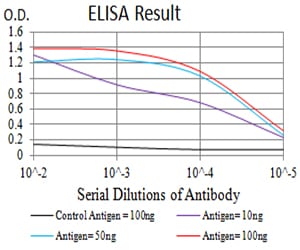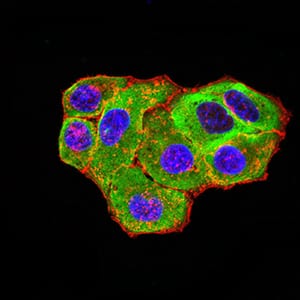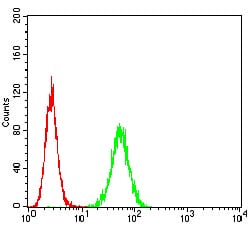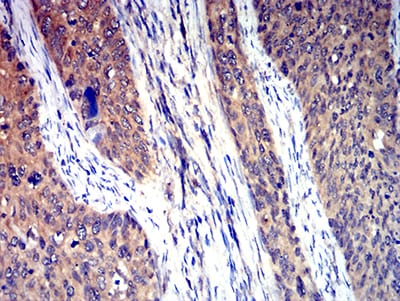



| WB | 咨询技术 | Human,Mouse,Rat |
| IF | 咨询技术 | Human,Mouse,Rat |
| IHC | 1/200 - 1/1000 | Human,Mouse,Rat |
| ICC | 1/100 - 1/500 | Human,Mouse,Rat |
| FCM | 1/200 - 1/400 | Human,Mouse,Rat |
| Elisa | 1/10000 | Human,Mouse,Rat |
| Aliases | HTR3; 5HT3R; 5-HT-3; 5-HT3A; 5-HT3R |
| Entrez GeneID | 3359 |
| clone | 4D5E7 |
| WB Predicted band size | 55.3kDa |
| Host/Isotype | Mouse IgG2a |
| Antibody Type | Primary antibody |
| Storage | Store at 4°C short term. Aliquot and store at -20°C long term. Avoid freeze/thaw cycles. |
| Species Reactivity | Human |
| Immunogen | Purified recombinant fragment of human HTR3A (AA: extra 24-157) expressed in E. Coli. |
| Formulation | Purified antibody in PBS with 0.05% sodium azide |
+ +
以下是关于HTR3A抗体的3篇模拟参考文献示例(内容为概括性描述,实际文献需通过学术数据库查询):
---
1. **文献名称**: "Characterization of HTR3A Antibody Specificity in Human Intestinal Tissue"
**作者**: Walstab, J., et al.
**摘要**: 本研究利用HTR3A特异性抗体,通过免疫组化和Western blot技术,揭示了5-HT3A受体在人类肠道神经元中的高表达模式,并验证了抗体在区分不同5-HT受体亚型中的高特异性,为肠道神经功能研究提供工具支持。
2. **文献名称**: "HTR3A Receptor Localization in Schizophrenia: An Immunohistochemical Study"
**作者**: Gaughran, F., et al.
**摘要**: 通过HTR3A抗体标记人脑前额叶皮层组织,发现精神分裂症患者中5-HT3A受体密度显著降低,提示该受体异常可能与疾病病理相关,为靶向治疗研究提供新方向。
3. **文献名称**: "Development of a Novel Monoclonal Antibody for HTR3A Receptor Functional Analysis"
**作者**: Thompson, A.J., & Lummis, S.C.
**摘要**: 报道一种新型单克隆抗体的开发,该抗体通过结合5-HT3A受体的胞外域抑制配体门控离子通道活性,为研究受体结构与功能关系及药物筛选提供了重要工具。
---
**提示**:实际文献可通过PubMed、Google Scholar等平台检索,关键词建议:
- `"HTR3A antibody" + immunohistochemistry`
- `"5-HT3A receptor" + antibody validation`
- `HTR3A + neurological disorders`
The HTR3A antibody is a research tool targeting the 5-hydroxytryptamine receptor 3A (HTR3A or 5-HT3A), a ligand-gated ion channel subunit critical for serotonin signaling. As part of the 5-HT3 receptor family, HTR3A forms homopentameric or heteropentameric complexes (with HTR3B) to mediate rapid neurotransmission in the central and peripheral nervous systems. These receptors are involved in regulating gut motility, nausea/vomiting reflexes, mood, and cognitive functions, making them therapeutic targets for conditions like chemotherapy-induced emesis and psychiatric disorders.
HTR3A antibodies are typically produced in hosts such as rabbits or mice using immunogenic peptides or recombinant protein fragments. They are widely used in techniques like Western blotting, immunohistochemistry (IHC), and immunofluorescence (IF) to map receptor expression in tissues, study receptor trafficking, or investigate disease-associated alterations. Specific clones (e.g., 3C1. 4C8) are validated for selectivity against extracellular or intracellular epitopes. Researchers also employ these antibodies to explore HTR3A's role in gut-brain axis communication, neuropsychiatric conditions (e.g., depression, schizophrenia), and drug responses. Cross-reactivity validation across species (human, mouse, rat) is essential for experimental accuracy. Commercial antibodies often include data on affinity (Kd values) and applications, aiding in mechanistic studies of serotonin signaling pathways.
×